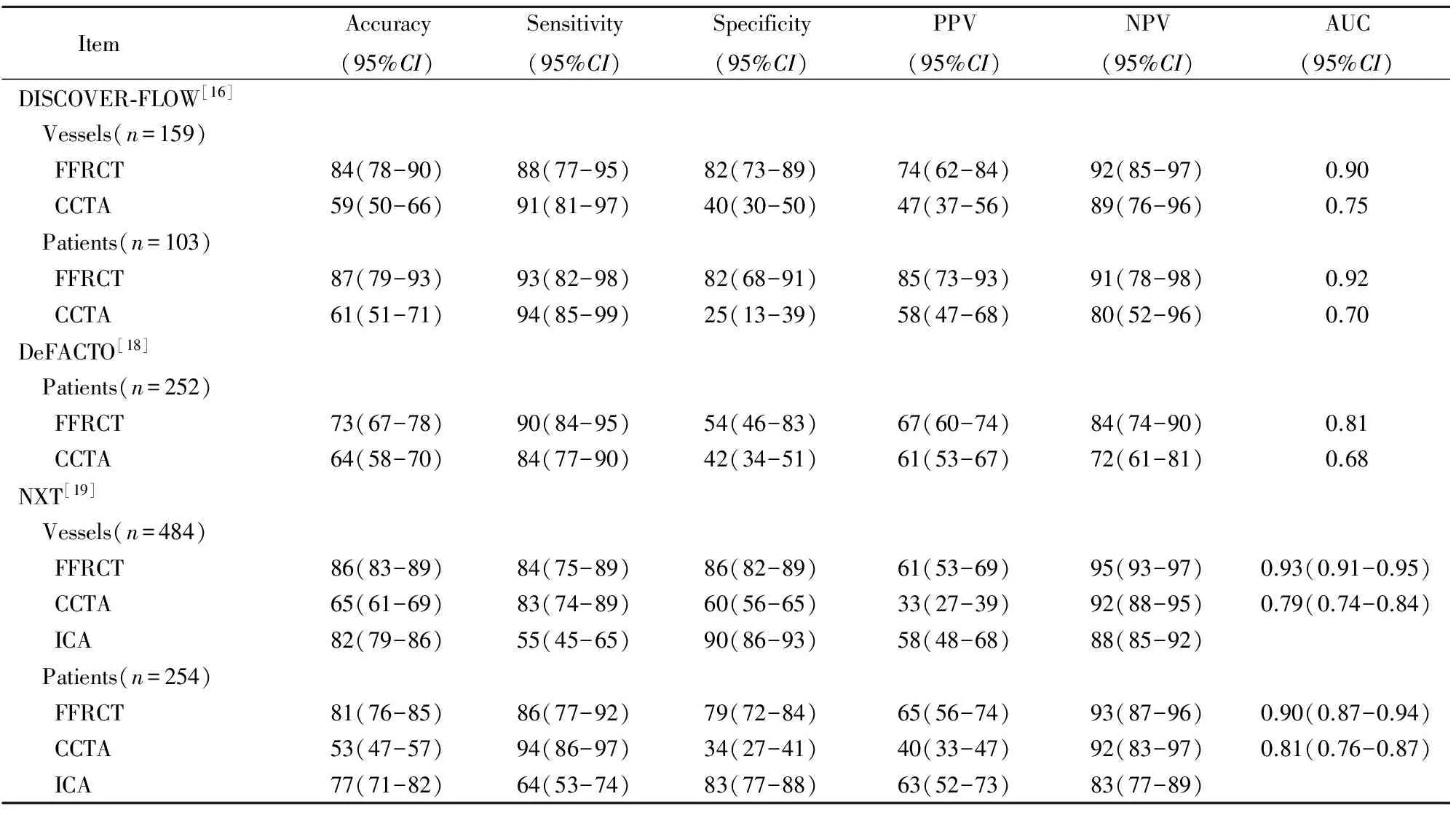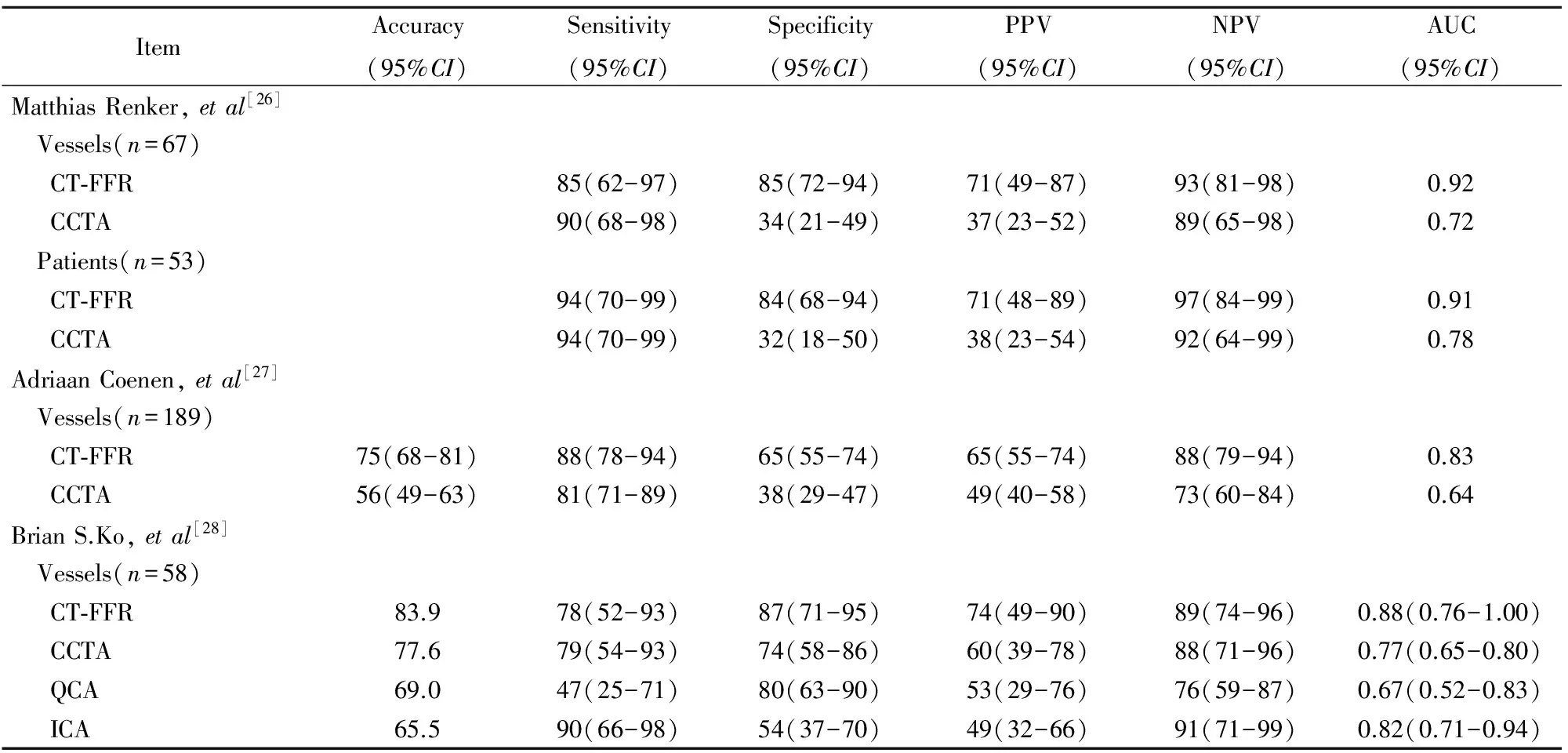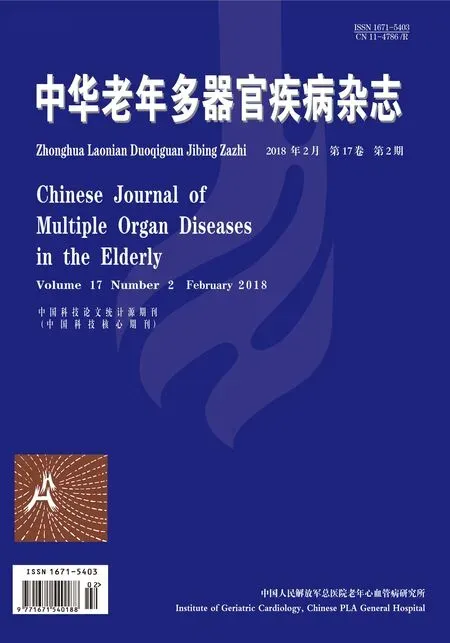无创血流储备分数测定对冠心病患者心肌缺血功能评估的临床进展
胡文超,曹丰
(解放军总医院心血管内科,北京 100853)
以往的研究表明,冠状动脉重度狭窄往往预示着心肌缺血存在。然而,随着研究的深入,人们逐渐发现冠状动脉狭窄严重程度与心肌缺血并不完全相关。有研究显示,在经冠状动脉CT血管造影(coronary computed tomographic angiography,CCTA)或侵入性冠状动脉造影(invasive coronary angiography,ICA)检查提示狭窄程度≥50%的阻塞性病变中,仅有约一半的病变导致了真正的心肌缺血[1,2];另一方面,狭窄程度≤50%的非阻塞性病变也可能会引起心肌缺血[3-5],提示冠状动脉解剖学狭窄并不一定代表功能性的心肌缺血。
冠状动脉血流储备分数(fractional flow reserve,FFR)概念的提出为冠状动脉狭窄的功能学评估开辟了新纪元,目前已成为诊断冠状动脉狭窄病变引起血流动力学异常的“金标准”[6,7]。FFR是指存在冠状动脉狭窄病变的情况下,该冠状动脉所供应区域心肌能获得的最大血流量与该区域理论上正常情况下能获得的最大血流量之比[8,9]。目前研究人员认为,引起冠状动脉血流动力学异常的FFR值在0.75~0.80之间[10-12]。FFR值<0.75的冠状动脉狭窄病变往往表现出心肌缺血的征象,而FFR值>0.80的病变则极少出现可诱导的心肌缺血征象[13,14]。
然而,FFR测定需要使用压力测定导丝,具有有创性、手术费用高、风险较高及辐射量大等缺点,因而不能成为诊断心肌缺血的常规检测。近年来,随着计算机流体动力学(computational fluid dynamics,CFD)技术的发展,衍生出了一种基于CCTA的无创性FFR(fractional flow reserve derived from coronary computed tomographic angiography,FFRCT)测定技术,相比经导管的有创FFR测定,FFRCT测定具有无创、经济、低风险、低辐射等优点。本文就FFRCT的基本概念、原理、临床研究进展、优缺点及应用前景作一综述。
1 概念及原理
1.1 概念
基于冠状动脉CTA图像,采用CFD的方法模拟冠状动脉狭窄在静息及药物负荷状态下的血流动力学状态,通过该无创方法计算出的FFR值即为FFRCT。
1.2 原理
随着CFD技术的发展,计算机可以通过CCTA数据模拟出冠状动脉的解剖模型和血液流体动力学模型。基于图像的血流模型的发展,使得在真实患者的特定模型中分割建立搏动的冠状动脉血流和压力模型成为可能;而且通过该模型,我们可以模拟出冠状动脉树的入口、出口边界条件,并能模拟出注射腺苷后的最大充血状态。根据既往研究,冠状动脉内血流状态遵循流体动力学物理规律,因此可以根据计算机建立的冠状动脉树模型和获取的边界条件,计算整个冠状动脉树的流体控制方程。最后,创建一个可以显示冠状动脉血液流速及压力的三维冠状动脉树模型,计算出各个点的FFR值[15]。
2 临床研究及进展
尽管FFRCT技术日益完善,临床应用前景良好,但是仍需在严格的临床试验中以有创FFR为“金标准”,对其临床有效性进行评估。无论是从目前著名的多中心大型临床研究,还是近期的一些单中心研究来看,FFRCT在识别心肌缺血方面均显示出良好的诊断性能。
2.1 多中心临床研究
关于FFRCT,目前国际上著名的多中心大型前瞻性临床研究包括DISCOVER-FLOW 研究[16]、DeFACTO 研究[17,18]、NXT 研究[19],以及PLATFORM研究[20]。其中前三者均以有创FFR为参考标准,是评价FFRCT诊断价值的临床研究;后者则是首次评估FFRCT检查指导临床决策的准确性和临床预后效果的队列研究。
DISCOVER-FLOW研究、DeFACTO研究和NXT研究纳入的研究对象主要是临床确诊或疑诊的成年冠状动脉疾病(coronary artery disease,CAD)患者,并在60 d内先后进行了CCTA、ICA和FFR检查。研究结果显示,无论是以靶血管、还是以患者为研究对象进行分析,FFRCT检查结果与FFR结果均呈现出良好的正相关性,且在诊断敏感性、特异性、阳性预测值、阴性预测值和准确性方面,FFRCT较CCTA均有明显提升;从各个研究的受试者工作特征(receiver operating characteristic,ROC)曲线分析来看,FFRCT的曲线下面积(area under the curve,AUC)均显示出其在识别患者缺血方面良好的诊断性能(表1)。值得一提的是,NXT研究纳入了更多的中度病变患者,使用了更加自动化的软件版本,并且严格按照指南加强了β-受体阻滞剂以及硝酸盐类药物的使用[21,22],这表明FFRCT检查在中度CAD患者中的应用前景也良好。另外,NXT研究中的一项亚组分析表明[23],两种检查技术具有高度的可重复性。
PLATFORM研究是首次评估FFRCT临床应用效果的连续性队列研究。研究结果显示,在由FFRCT指导的原计划行ICA的受试者中,有61%避免了有创检查,且取消ICA的受试者在1年随访中没有遭遇不良事件[24]。此外,使用CCTA联合FFRCT的诊断策略使得通过ICA检查显示非梗阻性疾病的发病率减少了83%,且该策略在减少医疗保健成本的同时能够提高患者生活质量[20,24,25]。
2.2 近期的单中心临床研究
传统的FFRCT操作及计算需要复杂地几何建模和高强度地血流分析计算过程,这往往需要由与患者进行CCTA检查地点异地的超级计算机来完成。近期,伴随着一种新型的、计算强度较低的冠状动脉降阶模型出现,使得计算机断层扫描血流储备分数(computed tomography fractional flow reserve,CT-FFR)值的计算在现场即可实现。目前,已经有一些研究者通过单中心临床研究[26-29],验证了使用该新型方法进行现场CT-FFR操作的准确性和可靠性。从这些研究结果中可以看出,这种新型算法在显著提高CT-FFR计算效率的同时,仍然保持了其在识别心肌缺血病变方面良好的诊断性能(表2)。
3 优缺点
由于FFRCT值是在基于CCTA图像的基础上运用CFD方法分析计算出来的,所以FFRCT不仅具有CCTA无创、安全、快速、经济等优点,而且FFRCT可提供整个冠状动脉生理功能学方面的信息。从上述多中心和单中心临床研究中也可以发现,FFRCT与FFR有高度相关性,在识别心肌缺血病变方面有较高的准确性。

表1 著名的FFRCT多中心临床研究
FFRCT: fractional flow reserve derived from coronary computed tomographic angiography; CCTA: coronary computed tomographic angiography; ICA: invasive coronary angiography; PPV: positive predictive value; NPV: negative predictive value; AUC: area under the curve; CI: confidence interval

表2 现场CT-FFR的单中心临床研究
CT-FFR: computed tomography fractional flow reserve; CCTA: coronary computed tomography angiography; ICA: invasive coronary angiography; QCA: quantitative coronary angiography; PPV: positive predictive value; NPV: negative predictive value; AUC: area under the curve; CI: confidence interval
FFRCT技术本身也存在一定的局限性。(1)高质量的CCTA图像数据是获得准确FFRCT值的关键,图像质量的好坏程度直接影响FFRCT值的准确性[30,31]。(2)过高的冠状动脉钙化积分(coronary artery calcium score,CACS)也会降低FFRCT的准确性[32]。(3)如今FFRCT技术尚未常规应用于临床实践。(4)对于FFR值在“灰度值(0.75~0.80)”范围内的患者,FFRCT的诊断性能欠佳[33]。(5)在微循环障碍的患者中,通过FFRCT计算往往会错误地估计病变远端的实际FFR值[15]。
4 应用前景
较之核素心肌显像等其他无创性心肌缺血评估方法[34],FFRCT有着其不可比拟的优势。尽管目前FFRCT在诊断急性冠脉综合征(acute coronary syndrome,ACS)、冠状动脉旁路移植(coronary artery bypass graft,CABG)术后、经皮冠状动脉介入(percutaneous coronary intervention,PCI)术后的应用情况仍然是未知的,相信随着CFD技术的发展,通过计算机模拟PCI术后或CABG术后患者的血流模型终将成为可能。Chinnaiyan等[35]发起了一项国际性多中心前瞻性临床研究(Assessing Diagnostic Value of Non-invasive FFRCT in Coronary Care,ADVANCE),该研究计划自2015年7月起累计纳入5000例稳定型心绞痛患者,预计2021年完成,旨在确定FFRCT/CCTA联合诊断策略能否显著改变稳定型心绞痛患者的管理方案。
诸如外周动脉、脑动脉、肾动脉等其他血管也有使用FFRCT技术评估血流动力学生理功能状态的可能性[15]。相信随着FFRCT技术的日趋成熟和标准化,再加上充分的临床研究证据,应用FFRCT技术指导临床医师选择相应管理策略指日可待[36]。
[1] Meijboom WB, Van Mieghem CA, Van Pelt N,etal. Compre-hensive assessment of coronary artery stenoses: computed tomography coronary angiographyversusconventional coronary angio-graphy and correlation with fractional flow reserve in patients with stable angina[J]. J Am Coll Cardiol, 2008, 52(8): 636-643. DOI: 10.1016/j.jacc.2008.05.024.
[2] Shaw LJ, Berman DS, Maron DJ,etal. Optimal medical therapy with or without percutaneous coronary intervention to reduce ischemic burden — results from the Clinical Outcomes Utilizing Revascula-rization and Aggressive Drug Evaluation (COURAGE) trial nuclear substudy[J]. Circulation, 2008, 117(10): 1283-1291. DOI: 10.1161/CIRCULATIONAHA.107.743963.
[3] Curzen N, Rana O, Nicholas Z,etal. Does routine pressure wire assessment influence management strategy at coronary angiography for diagnosis of chest pain?[J]. Circ Cardiovasc Interv, 2014, 7(2): 248-255. DOI: 10.1161/circinterventions.113.000978.
[4] Park HB, Heo R, ó Hartaigh B,etal. Atherosclerotic plaque characteristics by CT angiography identify coronary lesions that cause ischemia: a direct comparison to fractional flow reserve[J]. JACC Cardiovasc Imaging, 2015, 8(1): 1-10. DOI: 10.1016/j.jcmg.2014.11.002.
[5] Tonino PA, Fearon WF, De Bruyne B,etal. Angiographicversusfunctional severity of coronary artery stenoses in the FAME study: fractional flow reserveversusangiography in multivessel evalua-tion[J]. J Am Coll Cardiol, 2010, 55(25): 2816-2821. DOI: 10.1016/j.jacc.2009.11.096.
[6] Levine GN, Bates ER, Blankenship JC,etal. 2011 ACCF/AHA/SCAI guideline for percutaneous coronary intervention[J]. J Am Coll Cardiol, 2011, 58(24): e44-e122. DOI: 10.1016/j.jacc.2011.08.007.
[7] Windecker S, Kolh P, Alfonso F,etal. 2014 ESC/EACTS guidelines on myocardial revascularization: the task force on myocardial revascularization of the European Society of Cardiology (ESC) and the European Association for Cardio-Thoracic Surgery (EACTS) developed with the special contribution of the European Association of Percutaneous Cardiovascular Interventions (EAPCI)[J]. Eur Heart J, 2014, 35(37): 2541-2619. DOI: 10.1093/eurheartj/ehu278.
[8] Pijls NH, Van Gelder B, Van Der VP,etal. Fractional flow reserve: a useful index to evaluate the influence of an epicardial coronary stenosis on myocardial blood flow[J]. Circulation, 1995, 92(11): 3183-3193. DOI: 10.1161/01.CIR.92.11.3183.
[9] Kern MJ, Samady H. Current concepts of integrated coronary physiology in the catheterization laboratory[J]. J Am Coll Cardiol, 2010, 55(3): 173-185. DOI: 10.1016/j.jacc.2009.06.062.
[10] Bech GJ, De Bruyne B, Pijls NH,etal. Fractional flow reserve to determine the appropriateness of angioplasty in moderate coronary stenosis: a randomized trial[J]. Circulation, 2001, 103(24): 2928-2934. DOI: 10.1161/01.CIR.103.24.2928.
[11] De Bruyne B, Pijls NH, Kalesan B,etal. Fractional flow reserve-guided PCIversusmedical therapy in stable coronary disease[J]. N Engl J Med, 2012, 367(11): 991-1001. DOI: 10.1056/NEJMoa1205361.
[12] Tonino PA, De Bruyne B, Pijls NH,etal. Fractional flow reserveversusangiography for guiding percutaneous coronary interven-tion[J]. N Engl J Med, 2009, 360(3): 213-224. DOI: 10.1056/NEJMoa0807611.
[13] Lindstaedt M, Halilcavusogullari Y, Yazar A,etal. Clinical outcome following conservativevsrevascularization therapy in patients with stable coronary artery disease and borderline fractional flow reserve measurements[J]. Clin Cardiol, 2010, 33(2): 77-83. DOI: 10.1002/clc.20693.
[14] Pijls NH, Sels JW. Functional measurement of coronary stenosis[J]. J Am Coll Cardiol, 2012, 59(12): 1045-1057. DOI: 10.1016/j.jacc.2011.09.077.
[15] Taylor CA, Fonte TA, Min JK. Computational fluid dynamics applied to cardiac computed tomography for noninvasive quantification of fractional flow reserve: scientific basis[J]. J Am Coll Cardiol, 2013, 61(22): 2233-2241. DOI: 10.1016/j.jacc.2012.11.083.
[16] Koo BK, Erglis A, Doh JH,etal. Diagnosis of ischemia-causing coronary stenoses by noninvasive fractional flow reserve computed from coronary computed tomographic angiograms. Results from the prospective multicenter DISCOVER-FLOW (Diagnosis of Ischemia-Causing Stenoses ObtainedViaNoninvasive Fractional Flow Reserve) study[J]. J Am Coll Cardiol, 2011, 58(19): 1989-1997. DOI: 10.1016/j.jacc.2011.06.066.
[17] Min JK, Leipsic J, Pencina MJ,etal. Diagnostic accuracy of fractional flow reserve from anatomic CT angiography[J]. JAMA, 2012, 308(12): 1237-1245. DOI: 10.1001/2012.jama.11274.
[18] Min JK, Berman DS, Budoff MJ,etal. Rationale and design of the DeFACTO (Determination of Fractional Flow Reserve by Anatomic Computed Tomographic AngiOgraphy) study[J]. J Cardiovasc Comput Tomogr, 2011, 5(5): 301-309. DOI: 10.1016/j.jcct.2011.08.003.
[19] Norgaard BL, Leipsic J, Gaur S,etal. Diagnostic performance of noninvasive fractional flow reserve derived from coronary computed tomography angiography in suspected coronary artery disease: the NXT trial (analysis of coronary blood flow using CT angiography: next steps)[J]. J Am Coll Cardiol, 2014, 63(12): 1145-1155. DOI: 10.1016/j.jacc.2013.11.043.
[20] Douglas PS, Pontone G, Hlatky MA,etal. Clinical outcomes of fractional flow reserve by computed tomographic angiography-guided diagnostic strategiesvsusual care in patients with suspected coronary artery disease: the prospective longitudinal trial of FFR(CT): outcome and resource impacts study[J]. Eur Heart J, 2015, 36(47): 3359-3367. DOI: 10.1093/eurheartj/ehv444.
[21] Abbara S, Blanke P, Maroules CD,etal. SCCT guidelines for the performance and acquisition of coronary computed tomographic angiography: a report of the Society of Cardiovascular Computed Tomography Guidelines Committee: endorsed by the North American Society for Cardiovascular Imaging (NASCI)[J]. J Cardiovasc Comput Tomogr, 2016, 10(6): 435-449. DOI: 10.1016/j.jcct.2016.10.002.
[22] Abbara S, Arbab-Zadeh A, Callister TQ,etal. SCCT guidelines for performance of coronary computed tomographic angiography: a report of the Society of Cardiovascular Computed Tomography Guidelines Committee[J]. J Cardiovasc Comput Tomogr, 2009, 3(3): 190-204. DOI: 10.1016/j.jcct.2009.03.004.
[23] Gaur S, Bezerra HG, Lassen JF,etal. Fractional flow reserve derived from coronary CT angiography: variation of repeated analyses[J]. J Cardiovasc Comput Tomogr, 2014, 8(4): 307-314. DOI: 10.1016/j.jcct.2014.07.002.
[24] Douglas PS, De Bruyne B, Pontone G,etal. 1-year outcomes of FFRCT-guided care in patients with suspected coronary disease: the PLATFORM study[J]. J Am Coll Cardiol, 2016, 68(5): 435-445. DOI: 10.1016/j.jacc.2016.05.057.
[25] Hlatky MA, De Bruyne B, Pontone G,etal. Quality-of-life and economic outcomes of assessing fractional flow reserve with com-puted tomography angiography: PLATFORM[J]. J Am Coll Cardiol, 2015, 66(21): 2315-2323. DOI: 10.1016/j.jacc.2015.09.051.
[26] Renker M, Schoepf UJ, Wang R,etal. Comparison of diagnostic value of a novel noninvasive coronary computed tomography angio-graphy methodversusstandard coronary angiography for assessing fractional flow reserve[J]. Am J Cardiol, 2014, 114(9): 1303-1308. DOI: 10.1016/j.amjcard.2014.07.064.
[27] Coenen A, Lubbers MM, Kurata A,etal. Fractional flow reserve computed from noninvasive CT angiography data: diagnostic performance of an on-site clinician-operated computational fluid dynamics algorithm[J]. Radiology, 2014, 274(3): 674-683. DOI: 10.1148/radiol.14140992.
[28] Ko BS, Cameron JD, Munnur RK,etal. Noninvasive CT-derived FFR based on structural and fluid analysis: a comparison with invasive FFR for detection of functionally significant stenosis[J]. JACC Cardiovasc Imaging, 2017, 10(6): 663-673. DOI: 10.1016/j.jcmg.2016.07.005.
[29] Baumann S, Wang R, Schoepf UJ,etal. Coronary CT angiography-derived fractional flow reserve correlated with invasive fractional flow reserve measurements — initial experience with a novel physician-driven algorithm[J]. Eur Radiol, 2015, 25(4): 1201-1207. DOI: 10.1007/s00330-014-3482-5.
[30] Leipsic J, Yang TH, Thompson A,etal. CT angiography (CTA) and diagnostic performance of noninvasive fractional flow reserve: results from the determination of fractional flow reserve by anatomic CTA (DeFACTO) study[J]. Am J Roentgenol, 2014, 202(5): 989-994. DOI: 10.2214/AJR.13.11441.
[31] Min JK, Koo BK, Erglis A,etal. Effect of image quality on diag-nostic accuracy of noninvasive fractional flow reserve: results from the prospective multicenter international DISCOVER-FLOW study[J]. J Cardiovasc Comput Tomogr, 2012, 6(3): 191-199. DOI: 10.1016/j.jcct.2012.04.010.
[32] Nørgaard BL, Gaur S, Leipsic J,etal. Influence of coronary calcification on the diagnostic performance of CT angiography derived FFR in coronary artery disease[J]. JACC Cardiovasc Imaging, 2015, 8(9): 1045-1055. DOI: 10.1016/j.jcmg.2015.06.003.
[33] Tanaka K, Bezerra HG, Gaur S,etal. Comparison between non-invasive (coronary computed tomography angiography derived) and invasive-fractional flow reserve in patients with serial stenoses within one coronary artery: a NXT trial substudy[J]. Ann Biomed Eng, 2016, 44(2): 580-589. DOI: 10.1007/s10439-015-1436-y.
[34] 张琳, 严松彪, 陈晖, 等.99mTc-MIBI SPECT负荷心肌灌注显像对怀疑心肌缺血糖尿病患者的预后价值[J]. 中华老年多器官疾病杂志, 2017, 16(9): 672-676. DOI: 10.11915/j.issn.1671-5403.2017.09.158.
Zhang L, Yan SB, Chen H,etal. Prognostic value of stress myocardial perfusion imaging with99mTc-MIBI SPECT for diabetic patients with suspected myocardial ischemia[J]. Chin J Mult Organ Dis Elderly, 2017, 16(9): 672-676. DOI: 10.11915/j.issn.1671-5403.2017.09.158.
[35] Chinnaiyan KM, Akasaka T, Amano T,etal. Rationale, design and goals of the HeartFlow assessing diagnostic value of non-invasive FFRCTin Coronary Care (ADVANCE) registry[J]. J Cardiovasc Comput Tomogr, 2017, 11(1): 62-67. DOI: 10.1016/j.jcct.2016.12.002.
[36] Min JK, Taylor CA, Achenbach S,etal. Noninvasive fractional flow reserve derived from coronary CT angiography: clinical data and scientific principles[J]. JACC Cardiovasc Imaging, 2015, 8(10): 1209-1222. DOI: 10.1016/j.jcmg.2015.08.006.

